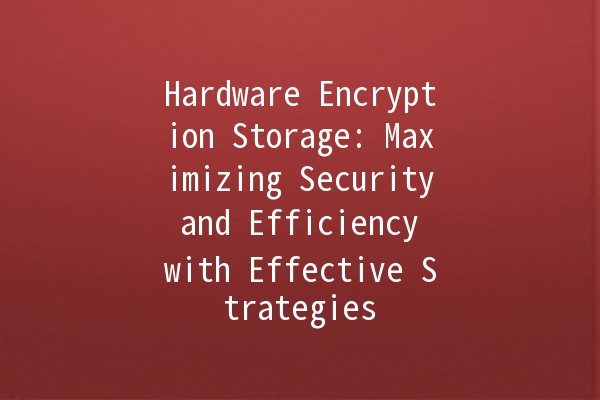




In an increasingly digital world, the significance of data security cannot be overstated. Organizations and individuals alike are looking for robust solutions to protect sensitive information from unauthorized access and breaches. Hardware encryption storage stands out as a reliable way to safeguard data while simultaneously enhancing productivity. This article provides valuable insights and practical tips on how to leverage hardware encryption storage to its fullest potential.
Before diving into specific techniques, it’s essential to understand what hardware encryption storage is. Hardware encryption involves using a physical device that encrypts data automatically at the hardware level. Unlike software encryption, which relies on the operating system, hardware encryption ensures that even if the device is compromised, the data remains secure.

Implementing hardware encryption storage effectively requires more than just choosing the right device. Here are five strategies that can significantly enhance productivity while ensuring data security.
Choosing the appropriate hardware is crucial. Consider the following factors when selecting:
Capacity: Assess your storage needs based on the data you handle. Larger capacities may be necessary for organizations, while individual users might require less.
Speed: Evaluate read and write speeds to ensure optimal performance. Solidstate drives (SSDs) tend to offer better speed than traditional hard drives.
Compatibility: Ensure the device works seamlessly with your existing systems and applications.
Example Application: A graphic design firm handling large video files may opt for an external SSD with hardware encryption that allows for quick file transfers while protecting sensitive project data.
Using hardware encryption storage adds an additional layer of security, but implementing access controls is equally important. Set permissions that limit access to only authorized personnel.
Example Application: In a healthcare setting, restrict access to patient data stored on encrypted devices to only doctors and nurses who need it for specific treatments. This ensures sensitive information remains confidential.
Keeping the firmware of your hardware encryption devices updated is crucial for maintaining security and performance. Manufacturers often release updates to address vulnerabilities and enhance functionality.
Example Application: A company can schedule routine checks every quarter to ensure all encryption storage devices are running the latest firmware, thereby minimizing potential risks from outdated software.
While hardware encryption adds a layer of security, data can still be lost due to device failures or accidental deletions. Regularly back up encrypted data to a secure location to prevent potential loss.
Example Application: An organization can establish a backup protocol that involves weekly backups to a secure cloud service with hardware encryption support, ensuring data redundancy and safety.
The human factor plays a significant role in data security. Educating employees about the importance of data protection and hardware encryption storage best practices can prevent security negligence.
Example Application: Conducting training sessions that cover how to use encrypted storage devices securely, recognizing phishing attempts, and adhering to access protocols can bolster a company’s overall security posture.
There are various types of hardware encryption storage devices, including external hard drives, USB flash drives, and whole disk encryption solutions for laptops and desktops. Choosing the right type often depends on the user’s specific needs and data protection requirements.
Hardware encryption secures data at the device level using dedicated chips, providing faster performance and enhanced security against attacks that target software vulnerabilities. Software encryption, on the other hand, relies on the operating system and can be more susceptible to malware.
Yes, hardware encryption storage is suitable for personal use, especially for individuals who handle sensitive information such as personal documents, financial records, or client data. It provides peace of mind knowing that their data is secure.
No, encrypted data cannot be accessed without the correct encryption key. This is one of the fundamentals of encryption—ensuring that only those with the proper credentials can decrypt and access the data.
If you lose a hardware encryption device, the data on it is secure as long as you do not share your encryption key. However, recovering data from the lost device may not be possible without the key, making it crucial to employ additional secure backup methods.
While many industries benefit from hardware encryption storage, sectors such as healthcare, finance, and legal services particularly require high levels of data protection due to the sensitive nature of the information they handle. Compliance with data protection regulations is critical in these fields.
By integrating hardware encryption storage into your data management strategy and employing the techniques outlined above, you can optimize security and enhance your productivity. Robust data protection is not just a necessary measure but a competitive advantage in today's digital landscape. Whether you're an individual or part of an organization, prioritizing secure storage solutions is essential for safeguarding your data and maintaining trust with clients and customers.